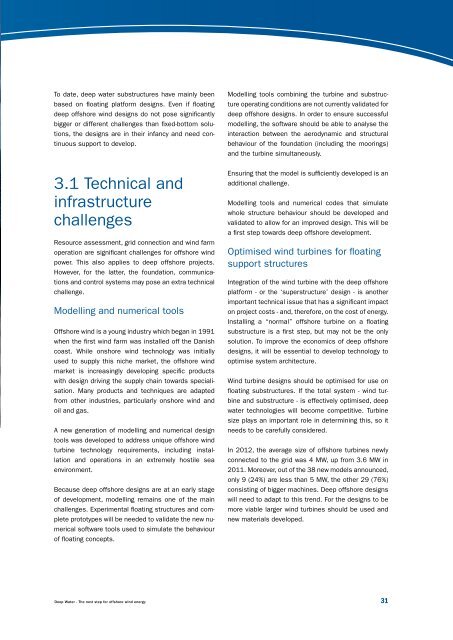Deep_Water
Deep_Water
Deep_Water
You also want an ePaper? Increase the reach of your titles
YUMPU automatically turns print PDFs into web optimized ePapers that Google loves.
To date, deep water substructures have mainly been<br />
based on floating platform designs. Even if floating<br />
deep offshore wind designs do not pose significantly<br />
bigger or different challenges than fixed-bottom solutions,<br />
the designs are in their infancy and need continuous<br />
support to develop.<br />
3.1 Technical and<br />
infrastructure<br />
challenges<br />
Resource assessment, grid connection and wind farm<br />
operation are significant challenges for offshore wind<br />
power. This also applies to deep offshore projects.<br />
However, for the latter, the foundation, communications<br />
and control systems may pose an extra technical<br />
challenge.<br />
Modelling and numerical tools<br />
Offshore wind is a young industry which began in 1991<br />
when the first wind farm was installed off the Danish<br />
coast. While onshore wind technology was initially<br />
used to supply this niche market, the offshore wind<br />
market is increasingly developing specific products<br />
with design driving the supply chain towards specialisation.<br />
Many products and techniques are adapted<br />
from other industries, particularly onshore wind and<br />
oil and gas.<br />
A new generation of modelling and numerical design<br />
tools was developed to address unique offshore wind<br />
turbine technology requirements, including installation<br />
and operations in an extremely hostile sea<br />
environment.<br />
Because deep offshore designs are at an early stage<br />
of development, modelling remains one of the main<br />
challenges. Experimental floating structures and complete<br />
prototypes will be needed to validate the new numerical<br />
software tools used to simulate the behaviour<br />
of floating concepts.<br />
Modelling tools combining the turbine and substructure<br />
operating conditions are not currently validated for<br />
deep offshore designs. In order to ensure successful<br />
modelling, the software should be able to analyse the<br />
interaction between the aerodynamic and structural<br />
behaviour of the foundation (including the moorings)<br />
and the turbine simultaneously.<br />
Ensuring that the model is sufficiently developed is an<br />
additional challenge.<br />
Modelling tools and numerical codes that simulate<br />
whole structure behaviour should be developed and<br />
validated to allow for an improved design. This will be<br />
a first step towards deep offshore development.<br />
Optimised wind turbines for floating<br />
support structures<br />
Integration of the wind turbine with the deep offshore<br />
platform - or the ‘superstructure’ design - is another<br />
important technical issue that has a significant impact<br />
on project costs - and, therefore, on the cost of energy.<br />
Installing a “normal” offshore turbine on a floating<br />
substructure is a first step, but may not be the only<br />
solution. To improve the economics of deep offshore<br />
designs, it will be essential to develop technology to<br />
optimise system architecture.<br />
Wind turbine designs should be optimised for use on<br />
floating substructures. If the total system - wind turbine<br />
and substructure - is effectively optimised, deep<br />
water technologies will become competitive. Turbine<br />
size plays an important role in determining this, so it<br />
needs to be carefully considered.<br />
In 2012, the average size of offshore turbines newly<br />
connected to the grid was 4 MW, up from 3.6 MW in<br />
2011. Moreover, out of the 38 new models announced,<br />
only 9 (24%) are less than 5 MW, the other 29 (76%)<br />
consisting of bigger machines. <strong>Deep</strong> offshore designs<br />
will need to adapt to this trend. For the designs to be<br />
more viable larger wind turbines should be used and<br />
new materials developed.<br />
<strong>Deep</strong> <strong>Water</strong> - The next step for offshore wind energy 31


